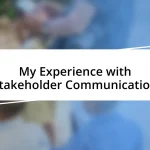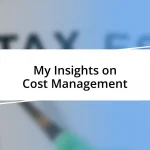Key takeaways:
- Financial literacy encompasses budgeting, investments, debt management, and savings strategies, adapting to personal goals and life stages.
- Key benefits of financial literacy include empowerment, reduced stress in financial decision-making, and enhanced investment knowledge.
- Fundamental concepts include distinguishing between needs and wants, the importance of compound interest, and the necessity of diversification in investing.
- Starting financial education with budgeting, setting goals, and automating savings builds a solid foundation for future financial success.
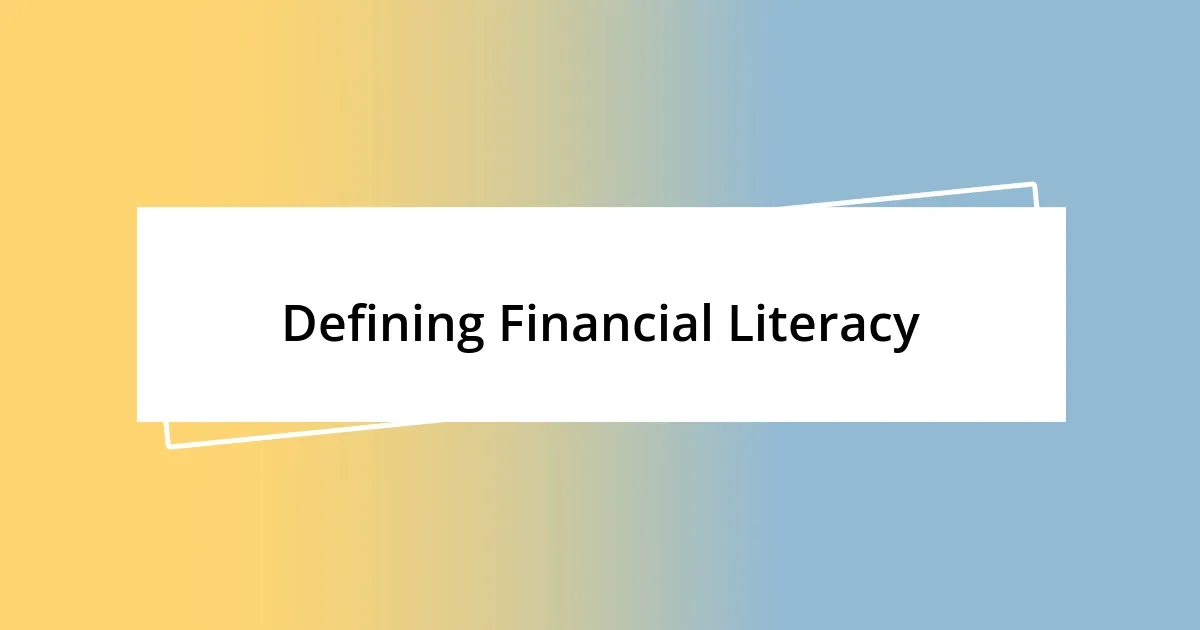
Defining Financial Literacy
Financial literacy is the ability to understand and effectively manage one’s financial resources. To me, this definition goes beyond just knowing how to budget; it encompasses understanding investments, debt management, and savings strategies. Have you ever found yourself overwhelmed by credit card statements or lost in a sea of investment jargon? I certainly have.
When I first started my journey, I thought being financially literate meant simply having a good job and saving a little each month. However, I quickly realized that it involves a deeper level of comprehension. It’s about differentiating between wants and needs, recognizing the impact of interest rates, and having the confidence to ask questions. There was a moment when I hesitated to negotiate my salary—could I have lost thousands just because I didn’t feel equipped to speak up?
I believe that financial literacy is not a one-size-fits-all skill; it adapts to our life stages and personal goals. For instance, as I transitioned from student life to adulthood, my priorities shifted dramatically, forcing me to reevaluate my understanding of loans and investments. How well do you know your financial landscape? This continual learning process is what makes financial literacy not just an educational goal, but a pivotal life skill.
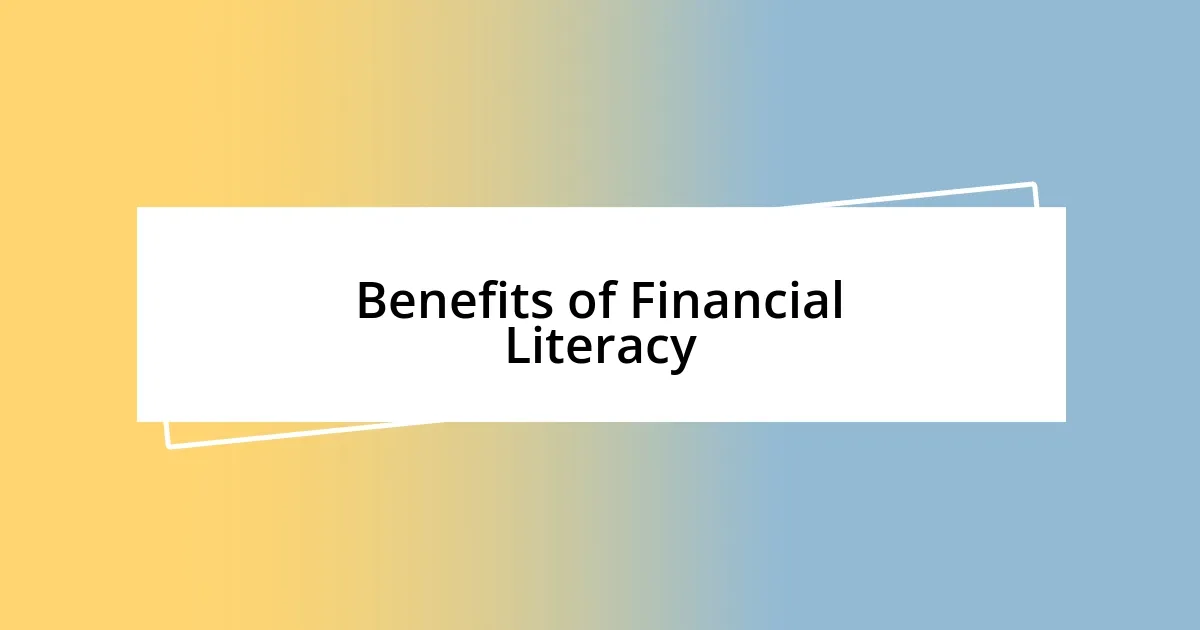
Benefits of Financial Literacy
Understanding the benefits of financial literacy can be a true game-changer. For instance, once I gained knowledge about budgeting, I felt a sense of empowerment. No longer did I feel anxious checking my bank balance; instead, I confidently planned my expenses each month. Have you ever felt that relief when your finances start to align with your expectations? It’s a profound experience.
Moreover, financial literacy opens doors to better investment opportunities. When I first started dabbling in the stock market, I was clueless. Then I took the time to educate myself, and I remember the thrill of watching my first investment grow. The difference was staggering—it was like going from watching a movie without sound to fully immersed in a captivating film.
Another overarching benefit is the reduction of stress related to financial decisions. I’ve found that being financially literate transforms indecision into clarity. I could recall a time I needed to make a significant purchase, and instead of panic, I used my skills to assess my options logically. Trust me, navigating through those decisions feels like a breath of fresh air.
| Benefit | Description |
|---|---|
| Empowerment | Financial literacy provides individuals with the confidence to manage their finances effectively. |
| Investment Knowledge | Understanding the basics of investing opens opportunities for wealth building. |
| Reduced Stress | Being financially literate leads to clearer decision-making and less anxiety. |
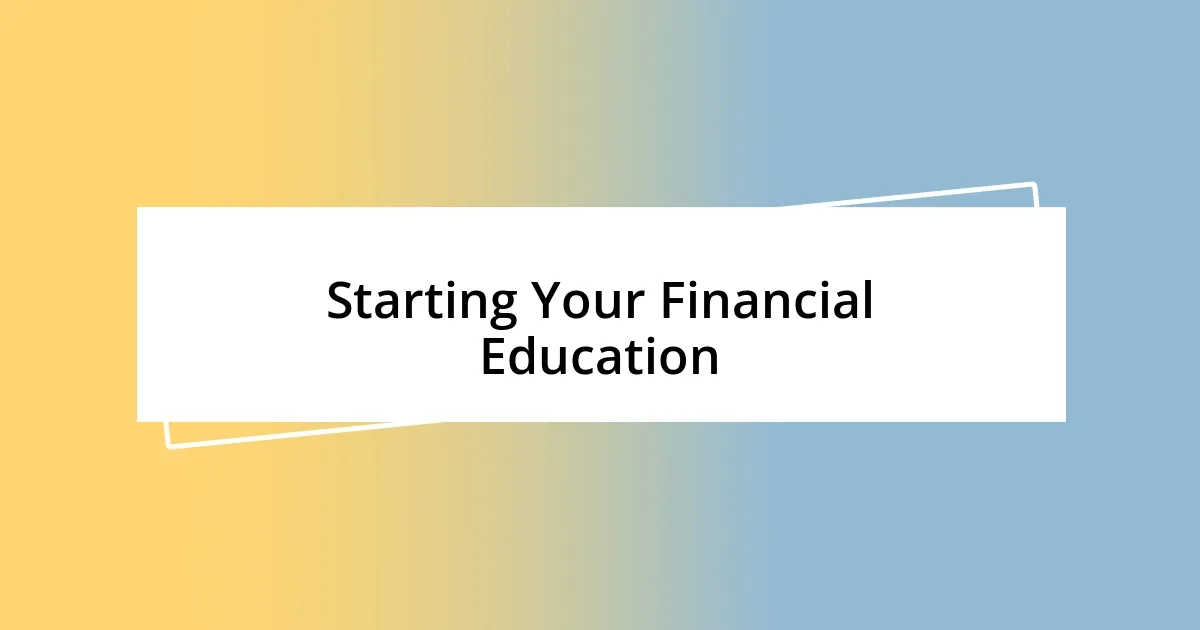
Starting Your Financial Education
As I began my financial education, I quickly realized that it’s essential to start with the basics. At first, I focused on personal budgeting. I remember sitting down one night with a simple spreadsheet, jotting down my income and all my expenses. It was eye-opening to see everything laid out in front of me. Suddenly, those small subscription services I barely used became glaring reminders of where I was wasting money. Starting small, like tracking what you spend, can lay a solid foundation for anything that comes next.
To kickstart your financial education, consider these initial steps:
- Assess Your Financial Situation: Take stock of your income, debts, and expenses. Knowing where you stand is crucial.
- Create a Budget: This doesn’t have to be complex. Just a simple plan for how you want to allocate your income can make a significant difference.
- Set Financial Goals: Whether saving for a vacation or paying off debt, having clear goals gives your financial education direction and purpose.
- Read and Research: There are countless books and online resources about personal finance; I found my first few guides invaluable in shaping my understanding.
- Engage with a Community: Surrounding yourself with financially savvy people or joining online forums can be a great support system as you learn.
Each of these steps can lead you to more profound insights into money management. I discovered that it’s not just about numbers; it’s about making informed decisions that resonate with your values and aspirations.
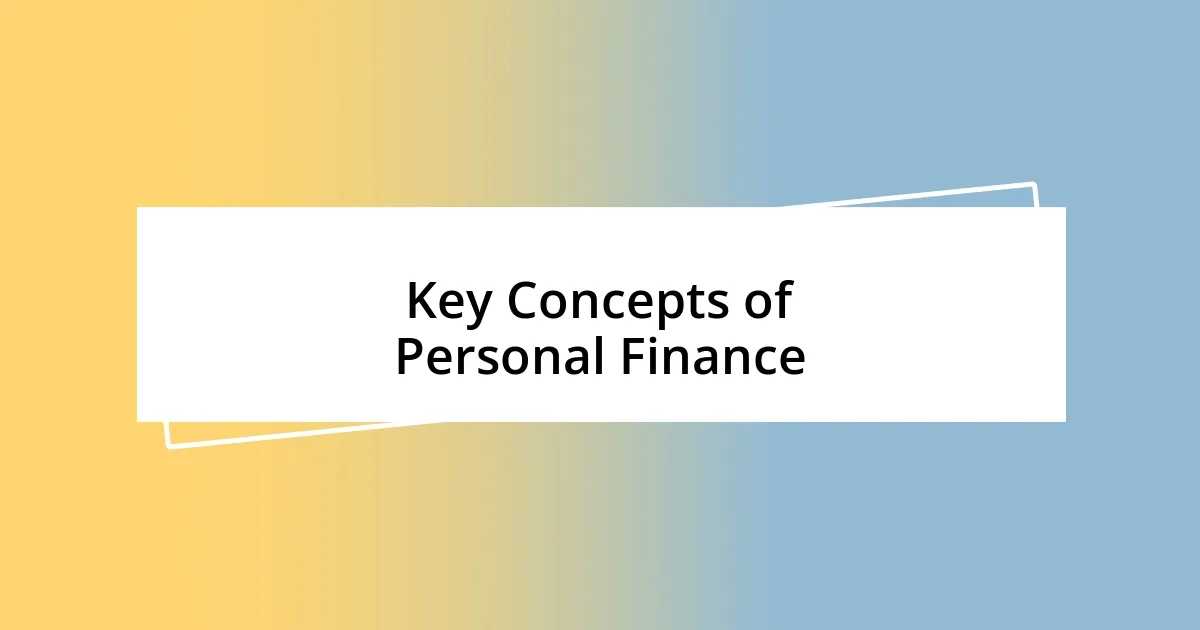
Key Concepts of Personal Finance
One of the key concepts of personal finance that really shifted my perspective was the importance of compound interest. I remember the moment I learned that by just starting to save early, I could watch my money grow over time. It’s like planting a tiny seed and nurturing it into a towering tree. Have you ever considered how even small contributions can lead to substantial financial growth? The earlier you start, the more time your money has to multiply.
Another foundational element is understanding the difference between needs and wants. Early on, I used to struggle with this concept. I recall a time when I was tempted to splurge on the latest gadget, but then I took a step back and evaluated my priorities. That moment felt almost liberating—it highlighted how many choices we make are based on impulse rather than necessity. By distinguishing these two categories, I realized I could redirect funds towards my savings or investments, which felt far more rewarding in the long run.
Lastly, the principle of diversification in investing cannot be overstated. When I first ventured into the stock market, I lost some money by putting everything into one risky asset—lesson learned! Now, I advocate for spreading investments across different asset classes. It’s like cooking a balanced meal; you don’t want to rely solely on one ingredient. Have you experienced the comfort that comes from knowing you’re protected against market fluctuations? This simple strategy has provided me with a sense of safety and opens doors to more stable growth opportunities.
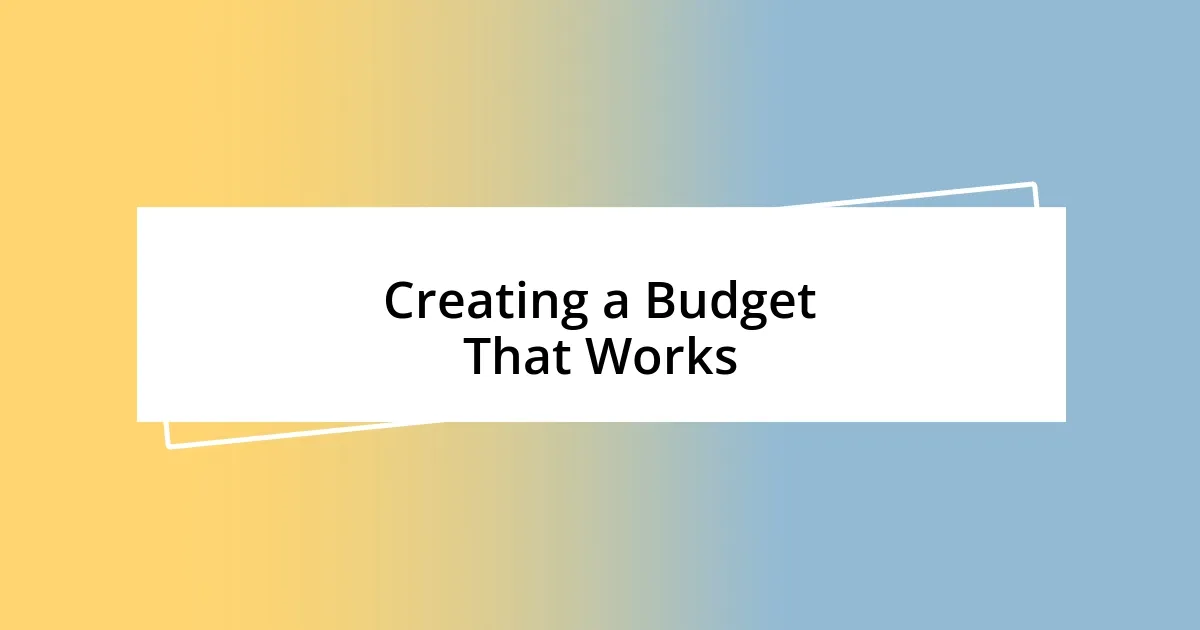
Creating a Budget That Works
Creating a budget that genuinely works is about aligning it with your life. I remember the frustration of trying to stick to a rigid budget that didn’t reflect my actual spending habits. It wasn’t until I adapted my budget to mirror my lifestyle that I truly found success. I started tracking my spending in categories that resonated with me, such as entertainment and dining out. This not only made budgeting feel less like a chore but also helped me allocate my money more effectively.
One technique that transformed my approach was the 50/30/20 rule. At first, I found it too simplistic, but when I tried it, the clarity was astounding. Allocating 50% of my income to needs, 30% to wants, and 20% to savings seemed like a straightforward proposition. It was reassuring to know that I could still treat myself while prioritizing my future. How does it feel to know that you can enjoy today while saving for tomorrow?
Lastly, I learned to reassess periodically. Life changes, and so do financial needs. I recall adjusting my budget after a significant life event, like moving into my own apartment. It forced me to sit down, review my expenses, and adapt accordingly. I even included a small “fun fund” for spontaneous outings, which I found was essential for maintaining a healthy balance between responsibility and enjoyment. Engaging in this ongoing dialogue with my budget made all the difference in not feeling restricted or overwhelmed. How do you find that balance between structure and flexibility in your own budgeting journey?

Building an Emergency Fund
Building an emergency fund is one of the most impactful financial decisions I’ve made. I remember when my car unexpectedly broke down; I was grateful to have set aside a small nest egg. That moment solidified the importance of this safety net for me—I realized it’s not just about saving, but about peace of mind. How would you feel knowing you’re prepared for life’s surprises?
I started my emergency fund based on the advice I read about saving three to six months’ worth of expenses. Initially, that felt daunting, but I broke it down into manageable monthly goals. Each time I reached a milestone, I felt a rush of accomplishment. Have you ever noticed how small victories can be incredibly motivating? They fueled my determination to keep going, reminding me that progress doesn’t have to happen overnight.
One technique that helped me was automating my savings. I set up a separate account and scheduled a monthly transfer right after payday. This made saving feel effortless—like a stress-free way of building my financial security. More importantly, it shifted my mindset. Instead of viewing saving as deprivation, I began to see it as a proactive step towards freedom. Does it surprise you how a small change can reshape your entire perspective on savings?
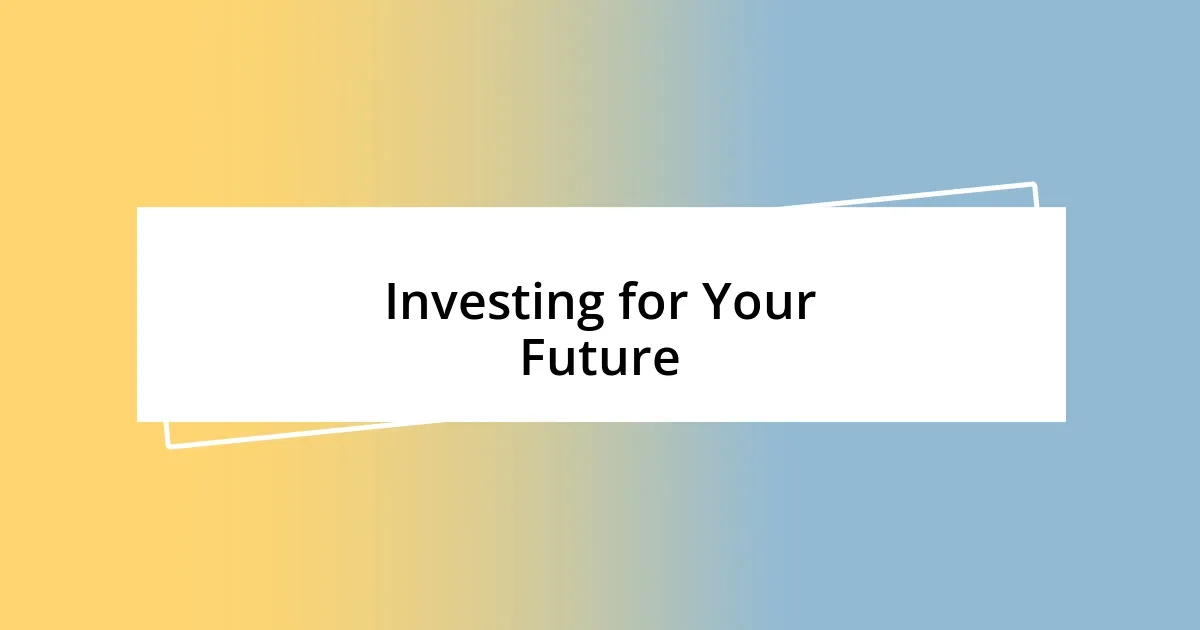
Investing for Your Future
Investing for your future doesn’t just mean buying stocks or bonds; it’s about cultivating a mindset of growth and opportunity. I vividly remember my first investment—a modest sum in a mutual fund. The weeks leading up to the decision were filled with doubts and second-guessing, but when I saw that initial return, I felt a thrill of excitement. Have you ever felt that rush of possibility when taking a risk that pays off?
As I ventured further into investing, I learned the importance of diversifying my portfolio. I recall a conversation with a mentor where they compared investing to a garden: plant various seeds for a richer harvest. This metaphor really resonated with me; I started exploring real estate, index funds, and even cryptocurrencies. Watching my investments bloom over time instilled a sense of patience and resilience in me. Have you considered how diversifying could impact your own financial future?
Staying informed is crucial in the investing world. I remember nights spent reading articles and watching webinars while sipping coffee, feeling an electric sense of accountability. It wasn’t just about numbers; it was about understanding the market landscape and making informed decisions. This proactive approach transformed my investment strategy and paved the way for continued growth. How often do you take the time to learn more about your investments and the financial world around you?













